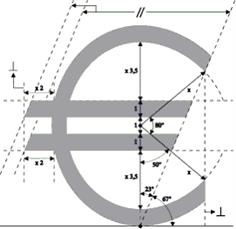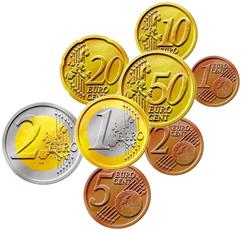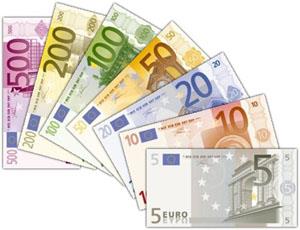Common european currency
E-day was January 1, 2002. It was the dawn of a new era, opening
a new chapter in European history as twelve of the countries in the European Union issued their new euro
banknotes and coins. E-day was the culmination of a six year programme to design
and print over 14 billion euro banknotes and mint 50 billion euro coins. A mammoth undertaking. Around ten
billion banknotes were put into circulation immediately, replacing national banknotes, while the rest were held
in reserve to replenish stocks. The banknotes were issued in seven denominations: €5, €10, €20,
€50, €100, €200 and €500 and the new coins came in eight denominations - 1, 2, 5, 10, 20 and
50 cent, and €1 and €2. One euro is equal to 100 cents.
The symbol chosen for the new currency (€) is inspired by the Greek letter "epsilon", which
is the first letter of the word Europe (ancient Greek name found in Greek mythology). The two parallel lines
indicate euro's stability. The official abbreviation for the new currency, which has also been registered with
the International Standards Organization (ISO) is EUR and can be used in financial, commercial and business
activities.
Euro coins
The eight euro coins vary in size, weight, material, colour and thickness
to facilitate recognition by the blind and the partially sighted. In addition the finish on the
edges of the euro coins is different for each consecutive denomination.
The coins have a common European side, designed by Luc Luycx of the Royal Belgian Mint.
These common sides feature three designs, each centred on a different map of Europe against the background of the
12 stars of the European Union flag. The map on the three lowest denominations - 1, 2 and 5 cent - shows Europe
in relation to the world. The 10, 20 and 50 cent coins represent the European Union as a group of individual
countries. To emphasise the unity of the European Union, the same group is shown as an integrated whole on the
€1 and €2 coins.


All coins are valid throughout the euro area, irrespective of the national sides of
the coins. The national sides are different in each of the 12 countries and depict familiar national motifs.
The high-value coins, the €1 and €2 coins, are bimetallic, with two different metals fused together,
clearly showing two different colours. Their production process involves the very latest technology, which
makes them difficult to counterfeit, as does the lettering around the edge of the €2 coin. A quality
management system has been put in place to ensure that the euro coins will be interchangeable throughout
the euro area. They will conform to the common standards necessary for use in all vending machines.
Though they are not members of the EU, Monaco, San Marino and Vatican City (but not
Andorra) also have euro coins featuring a national side, but these only occasionally end up in general
circulation as their scarcity leads to greater interest from coin collectors. The coins from Monaco feature
the royal family's coat of arms and seal and the portrait of the current ruler, Prince Rainier III. Those
from San Marino have various towers and public buildings from the small nation on them as well as the
national coat of arms and the Vatican coins present the portrait of Pope John Paul II. Having coins with
the effigy of a religious leader accepted as legal tender caused some controversy in certain countries
such as France. As for Andorra, it has secured the right to mint its own national reverse from the EU
since the country will join the EU tax evasion system in 2005. For the time being, the authority to mint
coins has been transfered from the Bishop of Urgell to the andorran goverment recently.
Euro design changes
Since the Euro was adopted in 2002, Belgium, Monaco and Spain have changed their national designs once, Vatican City
has changed theirs twice, Belgium amended their national design once and Finland did so twice. There are very strict
regulations governing the design and changes to the national face of Euro coins set forth by a combination of the European
Council and the European Central Bank. Some national designs fall outside of the letter of these guidelines for a number
of reasons:
| Member State |
Reason for non-compliance |
| Austria |
Lack of national identification |
| Germany, Greece |
Lack of national identification |
| Netherlands, Luxembourg |
Indication of the issuing Member State's name is not surrounded by the twelve stars
(€0.50, €0.20, €0.10, €0.05, €0.02 and €0.01)
Year mark is not surrounded by the twelve stars (€0.50, €0.20, €0.10, €0.05,
€0.02 and €0.01)
Twelve stars not depicted as on the European flag (€2.00 and €1.00)
|
| Slovenia |
Indication of the issuing Member State's name is not surrounded by the
twelve stars
Year mark is not surrounded by the twelve stars
|
Euro banknotes
The banknotes were designed by Robert Kalina, designer at the Austrian
national central bank in Vienna, who won the design competition. His designs were inspired by the theme
"Ages and styles of Europe". He has depicted the architectural styles of seven periods in our rich cultural
history (classical, roman, gothic, renaissance, baroque and rococo, steel and glass architecture, modern
20th century architecture). The resulting banknotes are attractive, have a number of security features and
are representative of all the Member States involved.

On the front of the banknotes, windows and gateways symbolise the spirit of openness and
co-operation in Europe. The 12 stars of the European Union appear on each banknote. On the reverse, a bridge
from the same architectural period is featured, symbolising the close co-operation and communication within
Europe, and between Europe and the world. The seven denominations of banknotes are printed with different
dominant colours to aid identification. The size of the banknotes varies, increasing with the value. The
€5 banknote is the smallest and the €500 the largest. The other main features of every euro banknote are:
- The name of the currency written in both the Latin (EURO) and the Greek (EYPO) alphabets
- The initials of the European Central Bank in the five linguistic variants - BCE, ECB, EZB, EKT,
EKP - covering the 11 official languages of the European Community
- The symbol © indicating copyright protection
- The signature of Willem F. Duisenberg, President of the European Central Bank
- The flag of the European Union
The different sizes and the bold, contrasting colours with "touch and feel"
characteristics will help the blind and the partially sighted to identify the banknotes. These are just two
of the four features incorporated into the banknotes after consultation with the European Blind Union. The
other two features are: the printing of the values in large, bold figures, and the use of the intaglio
printing process for some elements of the banknotes. Intaglio printing leaves the print raised in relief.
Such tactile marks are also printed along the edges of the higher-value €200 and €500 banknotes.
Commemorative issues
Euro commemorative coins are commemorative variations of euro circulation coins, in the sense that they have a
different national side from the standard one, and commemorate a specific event or personality. They comply with the
denominations and with the technical specifications of euro circulation coins and have legal tender status throughout
the euro area. As these coins must bear one of the common sides, the commemorative feature must appear on the
national side so that the common side remains unaffected.
The volume of coins and/or the production period of this coin variation are limited. It has been agreed between Member
States and the Commission that all commemorative coin issues would be limited to a single coin denomination (€2).
Euro collector coins, on the other hand, are not intended for circulation and must differ from regular euro coins, therefore:
- Their face value is different;
- They do not use images which are similar to the common and national sides of the circulation coins;
- Colour, diameter and weight differ significantly from the coins intended for circulation in at least two of
these three characteristics
- The legal tender status of these coins is also limited to the country of issue
Euro collector coin issues
According to the Conclusions of the Ecofin Council meeting on January 31, 2000, to ensure that Euro collector coins will
be readily distinguishable from Euro coins intended for circulation, the coins must bide to the following rules:
- The face value of collector coins should be different from that of the coins intended for circulation (i.e.
Euro coins cannot have a face value equal to the 8 denominations: 1, 2, 5, 10, 20, 50 Euro cent and 1 and 2 Euro)
- Collector coins should not use images, which are similar to the common sides of the euro coins intended for
circulation. Furthermore, as far as possible, the designs used should also be at least slightly different from those
of the national sides of circulation coins
- Out of colour, diameter and thickness, euro collector coins should differ significantly from the coins intended
for circulation in two respects
- Collector coins should not have a shaped edge with fine scallops, or "Spanish flower"
- The identity of the issuing Member State should be clearly and easily recognisable
Euro collector coins may be sold at or above face value and the approval for the volume of collector coins issue
should be sought on an aggregate basis rather than for each individual issue. With respect to collector coins'
denominations, that may coincide with the low denominations of euro banknotes, there does not seem to exist any significant
risk of substitution. However, Member States should stand ready to consider any demands by the ECB on this matter. While
Euro collector coins will have legal tender status in the issuing Member State, the competent authorities (NCBs, Mints or
other institutions) should set up temporary arrangements through which owners of euro collector coins issued in other
euro area Member States can receive the face value of those coins while bearing the costs related to this transaction.